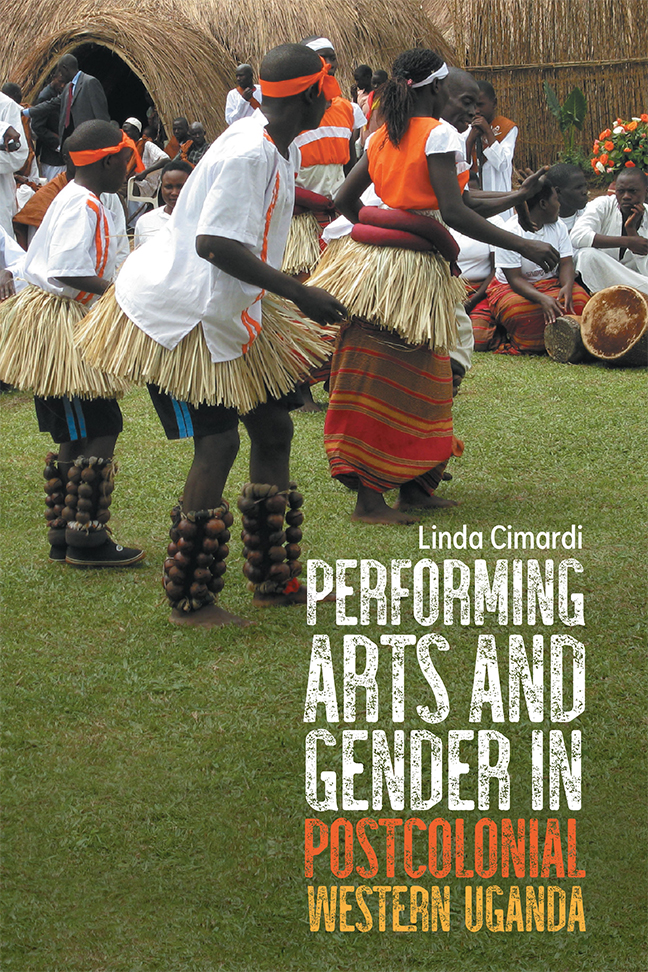Book contents
- Frontmatter
- Contents
- List of Illustrations
- Foreword
- Acknowledgments
- Note on Language
- Note on the Musical Examples
- Note on Online Audio and Video Material
- Prelude: Encountering Local Culture in Western Uganda
- Introduction: Approaching Gender and Performing Arts in Bunyoro and Tooro
- One “Traditional Dance Preserves Culture and Shows People How to Behave”: Runyege, MDD, and Gender
- Two Singing Marriage, Runyege, and Labor
- Three “Women Aren't Supposed To”: Instrument Playing in the Past and Today
- Four Shaking the Hips, Stamping the Feet: The Runyege Dance
- Five Narrating and Representing Local Culture: Theater in Songs and Dances
- Six Trans-Performing and Morality in Cultural Groups
- Postlude: Gendering Culture
- I Glossary of Terms in Runyoro-Rutooro
- II Historical Recordings from Bunyoro and Tooro
- Author's Interviews
- References
- Index
Introduction: Approaching Gender and Performing Arts in Bunyoro and Tooro
Published online by Cambridge University Press: 17 December 2023
- Frontmatter
- Contents
- List of Illustrations
- Foreword
- Acknowledgments
- Note on Language
- Note on the Musical Examples
- Note on Online Audio and Video Material
- Prelude: Encountering Local Culture in Western Uganda
- Introduction: Approaching Gender and Performing Arts in Bunyoro and Tooro
- One “Traditional Dance Preserves Culture and Shows People How to Behave”: Runyege, MDD, and Gender
- Two Singing Marriage, Runyege, and Labor
- Three “Women Aren't Supposed To”: Instrument Playing in the Past and Today
- Four Shaking the Hips, Stamping the Feet: The Runyege Dance
- Five Narrating and Representing Local Culture: Theater in Songs and Dances
- Six Trans-Performing and Morality in Cultural Groups
- Postlude: Gendering Culture
- I Glossary of Terms in Runyoro-Rutooro
- II Historical Recordings from Bunyoro and Tooro
- Author's Interviews
- References
- Index
Summary
In 1993, when Ugandan President Yoweri Museveni and his National Resistance Movement (NRM) government restored the precolonial monarchies that had been abolished in 1967, most of the populations living south of Lake Kyoga rejoiced (Reid 2017). Since Independence, the central power had been in the hands of the dictatorial presidents Milton Obote and later Idi Amin, both from the northern part of the country, where institutions like kingdoms did not exist. As a Southerner and the leader of the guerrilla army that chased out the previous dictator thanks to the support of Southerners, Museveni understood the political and cultural importance of restoring the traditional kingdoms. To many people in Buganda, Bunyoro, Tooro, and Nkore, the abolition of the kingdoms had meant an abuse of power by the central government and the removal of institutions that were carriers of a long history and heritage (Karlström 1999; Kiguli 2001).
While the Buganda Kingdom was so highly valued by British colonial administrators that its name was given to the entire Protectorate (Uganda being the Swahili version of Buganda), the most ancient kingdom of the African Great Lakes region had probably flourished in present western Uganda, in Bunyoro. According to some historians (Chrétien 1985 and 2000; Dunbar 1965; Majefe 1991), the Empire of Kitara originated in that area and later expanded to include most of southern Uganda, eastern Congo, northern Tanzania, Rwanda, and Burundi, between 1300 and 1650. Over the centuries, independent kingdoms emerged from the empire and different languages developed, but the various monarchies retained common features and rituals defining royalty, as well as the traditional religious complex (kubandwa) marked by spirit mediumship (Pennacini 1998).
These traits also marked the putative successor of the Kitara Empire, the Bunyoro Kingdom, and the newest realm that emerged from it around 1830, Tooro (Fig. I.1). The people living in these two kingdoms, the Banyoro and Batooro, speak the same idiom of the Bantu interlacustrine linguistic group, the Runyoro-Rutooro, although minor pronunciation and lexical variants connote the two areas. Furthermore, because of their common past, Bunyoro and Tooro have a similar social structure, involving an extended royal family, a sort of aristocracy composed of the chiefs’ families, and commoners, traditionally connoted as pastoralists (bahuma) or agriculturalists (bairu).
- Type
- Chapter
- Information
- Publisher: Boydell & BrewerPrint publication year: 2023

